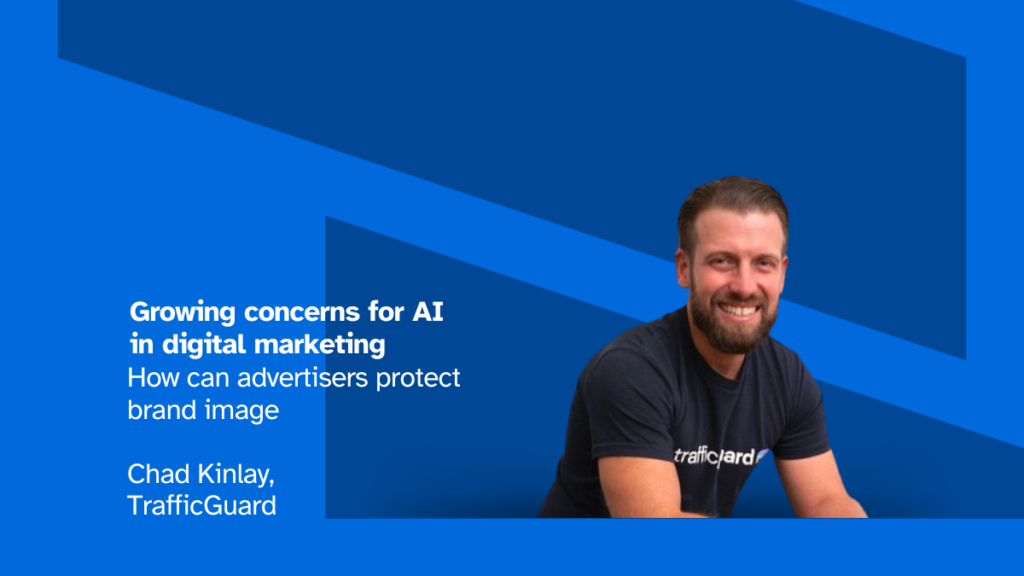By Chad Kinlay, Chief Marketing Officer at TrafficGuard
The rapid development of artificial intelligence (AI) in digital marketing has provided a new tool for driving growth, however, it’s not without risks and challenges. Users are more concerned than ever about how their data is being shared and used online.
To boost efficiency and adapt to a changing marketing landscape, marketers have embraced AI for a range of tasks. These include automating advertising, personalisation, and analysing large data sets to name a few.
Innovations like personalisation are being leveraged to encourage customer loyalty. According to McKinsey, 71% of consumers expect a personalised experience when interacting with a brand, and 76% feel frustrated when they don’t get it. What marketers don’t realise is that ‘handy’ AI platforms and tools are leaving them in the dark when it comes to strategy.
These tools often don’t relay vital ad performance insights to marketers. This lack of transparency and control over ads is putting marketers in danger of breaching the trust of their consumers. AI powered bots are also being used by competitors to match or undercut prices, putting further risk to budgets. Marketers need to take action now to gain visibility over their platforms to both benefit from AI and protect the interests of both themselves and users.
AI Poses New Challenges
To personalise customer experiences effectively, marketers must analyse large volumes of user data. Gathering and analysing large sets of data can be overwhelming for marketers, leading to the development of AI-driven platforms like Google’s Performance Max (PMax).
These platforms were designed to relieve the pressure on marketing teams by automating data collection and ad placement in real time. AI enables ads to be distributed more efficiently across multiple channels, such as YouTube, reaching broader audiences with minimal manual input. However, while AI tools increase efficiency, they have also created a new challenge for marketers, as they remove control from marketer’s hands over campaign management and strategy.
While this may not initially seem to be a problem, it means ads can potentially be shown where they shouldn’t be. If shown in the wrong places, marketers face a loss as their target audience isn’t reached.
However, an even bigger problem is that these ads could be shown to inappropriate audiences such as children, as was allegedly seen with PMax. If minors clicked on these ads, their data would be gathered, breaching data privacy laws. An incident like this would severely impact a brand’s reputation, so marketers can’t ignore the risks of AI automation.
Price-scraping bots are significantly draining budgets as competitors use them to extract pricing data and undercut prices, targeting future consumers. These bots can infiltrate systems through promotional offerings to extract valuable data. By mimicking human behaviour, they evade detection, draining financial resources as e-retailers have to adjust their prices and marketing efforts to remain competitive.
Protecting Retailers and Consumers
Marketers need to take charge of their audience targeting and data gathering. The ‘black box’ algorithms used by AI platforms don’t make it clear how they operate or where they obtain data from, leaving it to marketers to take the initiative themselves.
Marketers can take the following steps to protect both themselves and their audience from potential data privacy risks:
- Analyse traffic: Marketers can drastically reduce the risk of breaching privacy by taking a more detailed look into their traffic. By analysing where traffic has come from, marketers can ensure it isn’t coming from the wrong demographic or location. Bots can also be identified and reported before they have a chance to extract crucial data.
- Data Filtering: Marketers can also implement solutions to filter through data, enabling organisations to carefully craft their data collection strategy. With this in place, marketers can limit or halt data collection from consumers post-click. This ensures collected data aligns with protection regulations, especially when it comes to engagement from minors. Data collection can also be minimised so only the essentials for fraud identification and campaign optimisation are gathered. This will reduce the risk of damaging consumer trust.
Ensuring Brand Integrity
Maintaining consumer trust is integral to protecting a brand. AI-driven platforms such as PMax are currently not providing the trust and transparency marketers and users need. This means marketers have to take a proactive stance and protect themselves and consumers from inappropriate data practices.
By implementing the steps to analyse and filter data, marketers can minimise the potential risks and threats of AI platforms while still benefitting from them. Marketers will be empowered to protect both consumer trust and their own data from underhanded AI tactics.












